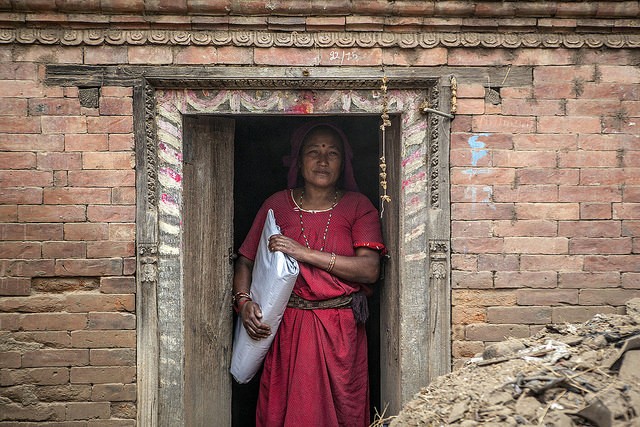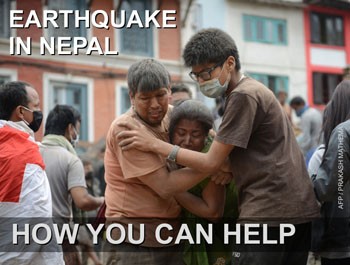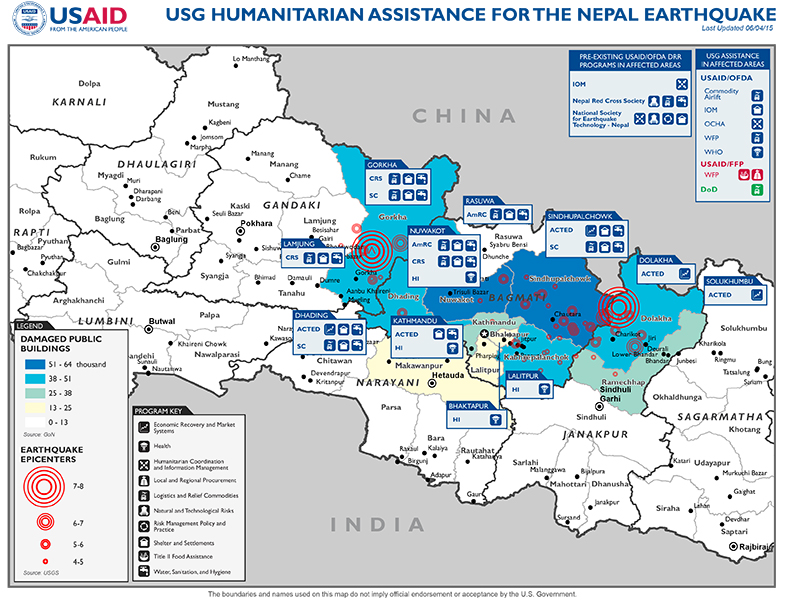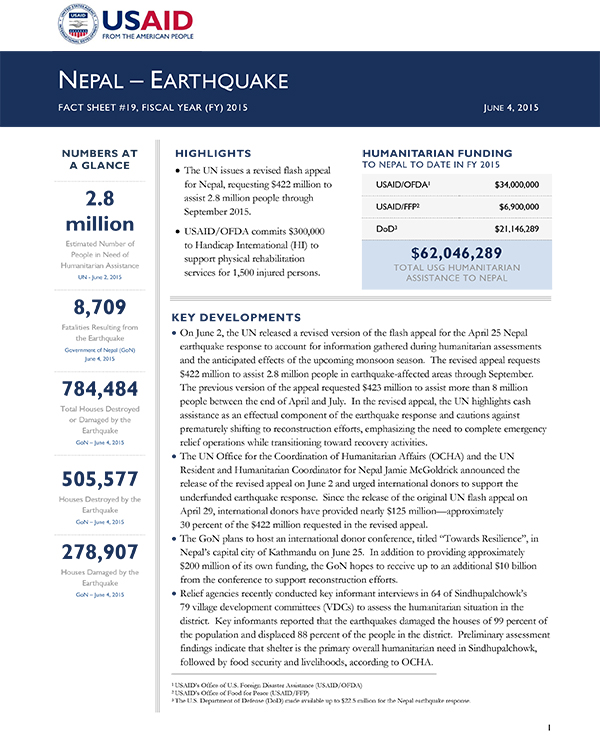June 4, 2015
Highlights
The UN issues a revised flash appeal for Nepal, requesting $422 million to assist 2.8 million people through September 2015.
USAID/OFDA commits $300,000 to Handicap International (HI) to support physical rehabilitation services for 1,500 injured persons.
Key Developments
On June 2, the UN released a revised version of the flash appeal for the April 25 Nepal earthquake response to account for information gathered during humanitarian assessments and the anticipated effects of the upcoming monsoon season. The revised appeal requests $422 million to assist 2.8 million people in earthquake-affected areas through September. The previous version of the appeal requested $423 million to assist more than 8 million people between the end of April and July. In the revised appeal, the UN highlights cash assistance as an effectual component of the earthquake response and cautions against prematurely shifting to reconstruction efforts, emphasizing the need to complete emergency relief operations while transitioning toward recovery activities.
Nepal Map - 06-04-2015 ![]() (pdf - 1010k)
(pdf - 1010k)
Numbers At A Glance
2.8 million
8,709
784,484
505,577
278,907
Humanitarian Funding:
To Nepal To Date In FY2015:
| USAID/OFDA | $34,000,000 |
| USAID/FFP | $6,900,000 |
| DoD | $21,146,289 |
| TOTAL | $62,046,289 |
Nepal Earthquake Fact Sheet #19 - 06-04-2015 ![]() (pdf - 199k)
(pdf - 199k)
The UN Office for the Coordination of Humanitarian Affairs (OCHA) and the UN Resident and Humanitarian Coordinator for Nepal Jamie McGoldrick announced the release of the revised appeal on June 2 and urged international donors to support the underfunded earthquake response. Since the release of the original UN flash appeal on April 29, international donors have provided nearly $125 million—approximately 30 percent of the $422 million requested in the revised appeal.
The GoN plans to host an international donor conference, titled “Towards Resilience”, in Nepal’s capital city of Kathmandu on June 25. In addition to providing approximately $200 million of its own funding, the GoN hopes to receive up to an additional $10 billion from the conference to support reconstruction efforts.
Relief agencies recently conducted key informant interviews in 64 of Sindhupalchowk’s 79 village development committees (VDCs) to assess the humanitarian situation in the district. Key informants reported that the earthquakes damaged the houses of 99 percent of the population and displaced 88 percent of the people in the district. Preliminary assessment findings indicate that shelter is the primary overall humanitarian need in Sindhupalchowk, followed by food security and livelihoods, according to OCHA.
DISPLACEMENT AND SHELTER
To date, the April 25 earthquake and aftershocks have damaged or destroyed nearly 784,500 houses, according to the GoN. The UN reports that approximately 91,500 people continued to reside in 374 temporary displacement sites across 12 of Nepal’s 14 most-affected districts as of June 2.
As of May 24, the International Organization for Migration (IOM) reported that approximately 21,600 people were sheltering in 64 displacement sites throughout Kathmandu Valley, including 15,100 people sheltering in 32 open spaces that were previously identified through IOM’s USAID/OFDA-funded Open Spaces program. The number of displaced persons in Kathmandu Valley, which comprises Bhaktapur, Kathmandu, and Lalitpur districts, has declined by nearly 50 percent—approximately 20,000 people—since early May, according to IOM’s Displacement Tracking Matrix.
Providing shelter support in advance of the monsoon season remains an urgent response priority. As of June 2, the Shelter Cluster—the coordinating body for humanitarian shelter activities, comprising UN agencies, non-governmental organizations, and other stakeholders—reported reaching 762,300 people with shelter assistance—approximately 40 percent of the 1.9 million people targeted to receive support.
USAID/OFDA has airlifted 6,200 rolls of plastic sheeting to Nepal to provide emergency shelter assistance for approximately 62,000 earthquake-affected households—up to 310,000 people. In addition, USAID/OFDA has provided more than $3.9 million to implementing partners to support shelter interventions.
HEALTH
The Health Cluster is requesting $41.8 million through the flash appeal to restore health care services in earthquakeaffected areas of Nepal and provide treatment and rehabilitation services for people injured as a result of the April 25 earthquake and aftershocks. Cluster partners are also working to strengthen disease surveillance systems in affected areas to prevent outbreaks of water- and vector-borne illnesses—a particular concern due to overcrowded conditions in displacement sites and the impending monsoon season.
USAID/OFDA recently committed $300,000 to HI to support physical rehabilitation services for an estimated 1,500 injured persons and 900 caregivers in Kathmandu Valley and other earthquake-affected areas. Providing emergency rehabilitation care reduces the risk of health complications and permanent impairments, while also increasing the independence and mobility of injured persons. HI plans to work with health facilities to enhance staff capacity to assess and properly manage patients in need of rehabilitation care and will also provide direct care and assistive devices to people outside of health facilities.
On May 26, USAID/OFDA provided $500,000 to the UN World Health Organization (WHO) to strengthen disease surveillance in Nepal. WHO is also working to provide essential health services to affected populations, support districtlevel GoN coordination, and establish water and sanitation systems at health facilities.
LOGISTICS, RELIEF COMMODITIES, AND WASH

The GoN and relief agencies continue to focus on preparing for the impending monsoon season, which will likely restrict access to many populations in need, particularly in mountainous areas. The GoN reports stockpiling food at staging areas and distribution points and pre-positioning heavy equipment in landslide-prone areas to facilitate the distribution of humanitarian assistance during monsoon season.
With more than $1.1 million of USAID/OFDA support, Catholic Relief Services (CRS) is providing emergency relief commodities and shelter assistance to nearly 12,500 earthquake-affected households in Dhading, Gorkha, and Lamjung districts. CRS is also partnering with a mountain trekking organization to deliver relief items to earthquake-affected populations in remote areas, as well as pre-positioning supplies for continued support during the monsoon season.
As of June 1, CRS had provided three-month water, sanitation, and hygiene (WASH) kits—comprising basic hygiene materials, oral rehydration salts, soap, and water treatment supplies—to nearly 1,300 households in Gorkha, ensuring access to critical WASH assistance through the monsoon season. To date, USAID/OFDA has provided more than $1.6 million to implementing partners to support WASH interventions in earthquake-affected areas of Nepal.
FOOD SECURITY AND AGRICULTURE
On May 27, the Nepal Food Security Monitoring System (NeKSAP)—supported by the UN World Food Program (WFP) and the Food Security Cluster—released a report on the food security situation in 11 of the most-affected districts based on household-level food security surveys and market assessments conducted on May 8–20. The assessment found that food security has deteriorated in assessed districts following the April 25 earthquake, with at least 1.4 million people currently requiring food assistance. In March, NeKSAP classified the 11 districts, comprising 627 VDCs, as minimally food insecure—the lowest of four food insecurity levels. However, the May NeKSAP assessment identified 80 VDCs as severely food insecure, 277 VDCs as highly food insecure, 172 VDCs as moderately food insecure, and only 98 VDCs as minimally food insecure.
The Food Security Cluster is requesting $98.6 million through the revised flash appeal to target 1.4 million people with emergency food assistance and provide approximately 220,000 households—1 million people—with support to help restore agricultural livelihoods.
USAID/FFP is providing $6.9 million to support WFP’s emergency food assistance operations in Nepal, including approximately $4.4 million of in-kind emergency food assistance from its warehouse in Colombo, Sri Lanka, and $2.5 million for the regional procurement of rice. As of June 1, WFP reported reaching more than 1.9 million people through general food distributions in earthquake-affected areas.
CONTEXT
On April 25, a magnitude 7.8 earthquake struck central Nepal’s Gorkha District, approximately 77 kilometers (km) northwest of Kathmandu, at a shallow depth of approximately 15 km, according to the U.S. Geological Survey (USGS).
The USG immediately issued a disaster declaration for Nepal due to the effects of the earthquake. Within hours of the seismic event, USAID/OFDA activated a Response Management Team (RMT) in Washington, D.C., and deployed a Disaster Assistance Response Team (DART)—including urban search-and-rescue (USAR) specialists—to Nepal.
On May 12, a magnitude 7.3 aftershock struck Nepal’s Dolakha District, approximately 76 km northeast of Kathmandu, according to USGS. The aftershock caused further casualties and damage in areas affected by the April 25 earthquake.
For nearly two decades, USAID/OFDA has supported disaster risk reduction (DRR) efforts in Nepal, including throughout Kathmandu Valley. USAID/OFDA funding has enabled partners to identify, prepare, and preserve more than 80 open spaces in Kathmandu Valley for humanitarian purposes; pre-position critical emergency relief supplies; and strengthen earthquake response capacity at the local and national levels in collaboration with the GoN, nongovernmental organizations, private companies, and local communities. More information on USAID/OFDA’s DRR programs in Nepal and throughout South Asia is available at www.usaid.gov/what-we-do/working-crises-andconflict/disaster-risk-reduct....
PUBLIC DONATION INFORMATION
The most effective way people can assist relief efforts is by making cash contributions to humanitarian organizations that are conducting relief operations. A list of humanitarian organizations that are accepting cash donations for disaster responses around the world can be found at www.interaction.org.
USAID encourages cash donations because they allow aid professionals to procure the exact items needed (often in the affected region); reduce the burden on scarce resources (such as transportation routes, staff time, and warehouse space); can be transferred very quickly and without transportation costs; support the economy of the disaster-stricken region; and ensure culturally, dietary, and environmentally appropriate assistance.
More information can be found at:
- The Center for International Disaster Information: www.cidi.org or +1.202.821.1999.
-
Information on relief activities of the humanitarian community can be found at www.reliefweb.int.










Comment
Make a general inquiry or suggest an improvement.